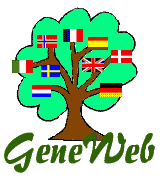

|
GeneWeb - Customization of pages |
Welcome page
| Macros
| Associated pages
| Customization of all the pages
| |
![]()
These files contain HTML mixed with "macros" (see following section). If you want to create such files or modify them, do not use an HTML editor, but a normal text editor.
To build the welcome page of the base "foo", GeneWeb will look for the following files, in this order:
bdir/lang/lg/foo.txt
| hdir/lang/lg/foo.txt
| bdir/lang/foo.txt
| hdir/lang/foo.txt
| bdir/lang/lg/start.txt
| hdir/lang/lg/start.txt
| bdir/lang/start.txt
| hdir/lang/start.txt
| |
"bdir" = value of "-bd" of the command "gwd" (default: current
directory).
| "hdir" = value of "-hd" of the command "gwd" (default: current
directory).
| "lg" = current language.
| |
The files "hdir/lang/lg/start.txt" are provided with the distribution. To make the custom file, the simplest way is to start from a copy of a file "start.txt" which you will arrange as you want. If the presentation of the files "start.txt" do not suit you, you can also change them directly.
Warning however: from a version of GeneWeb to the other, the files "start.txt" may have been improved. If you take a new version and want to benefit from the improvements, look at the files "start.txt" to see where they have been modified and include their modifications in your customized files.
![]()
These macros is replaced by values which depend on the context: name of the base, language, number of persons in the base, etc.
There is also a particular processing for the brackets "[" and "]": if the text between hooks is translated in the current language from the lexicon (file "lexicon.txt") with the following modifications:
If there is a star after the opening bracket, the first letter of
the translation is capitalized.
| If the closing bracket is followed of a number, that correspond to
the N-2nd occurrence of translation (starting with 0), the occurrences
being separated by slashes. If this occurrence does not exist, the
first one is taken.
| |
To understand how the macros are used, the best is to look at the files "start.txt" provided in the distribution.
Here the meanings of the macros "%":
Base.
Count. |
Conditionals. | Conditionals start with "%I" followed by a boolean expression (true or false) and end with "%E". The text between these two macros is displayed if and only if the boolean expression is true. A boolean expression is either:
Others. |
|
Some macros refer to contextual variables. They are:
b: in CGI mode, database name.
| lang: language.
| iz: number of the person taken as Sosa reference if any.
| |
![]()
For example, if you want to put a special page of the famous persons of your base, make a file named "famous.txt" in the directory "bdir/lang/lg" or in the directory "bdir/lang" (see first section).
The request of access to "famous.txt" is: "m=H;v=famous". In the welcome page, you will thus put:
<a href="%sm=H;v=famous">Famous</a> persons of my database.
In "famous.txt", you can put links to persons of your base, independently from his name and from the context, using the appropriate macros.
The particularly interesting macros are:
"%b" you can put in the tag
"<body>" writing it "<body%b>".
| "%s" you can use in links.
| |
See my cousin <a href="%sp=louis;n=de+bourbon;oc=5"> Louis XIV</a> and my <a href="%sem=R;ep=john;en=smith;m=NG;n=louis+xiv;t=PN"> relationship links</a> with him.
See how to make correct links to GeneWeb pages as well.
Notice that the "advanced request" works like an associated file named "advanced.txt".
![]()
You can add a file named base.hed (if "base" is the name
of your database) which will be inserted in all the headers of the pages
(between <head> and </head>). Allow you to insert style sheets
for example. To be put in the directory "lang" and/or if you want that it
be different for the language "xy" in the directory "lang/xy".
| In the same way, you can add a file named base.trl which will
be inserted behind the GeneWeb copyright at each page.
| At last, you can set the variable body_prop of your file
base.gwf which will be inserted in the tag "<body>" of all
the pages. Useful to put a background color or image or to change the
colours of the displayed texts. See this section
of the chapter "how to start with GeneWeb".
| |
![]()
![]()